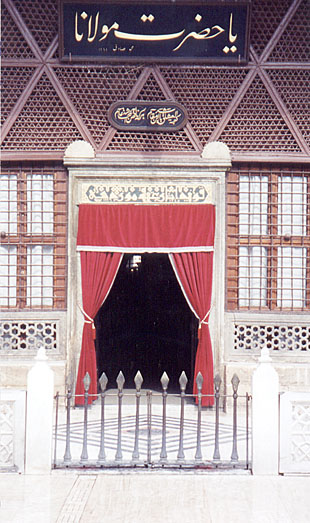
The Entry ticket to the mausoleum. The actual
mausoleum is under the green cone to the left. The central building is
the mosque.
 |
|
The Entry ticket to the mausoleum. The actual
mausoleum is under the green cone to the left. The central building is
the mosque.
|
Rumi was a Sufi sage born 1207 in Afghanistan, who taught in Konya. He founded the so-called Whirling Dervishes, who obtain a state of ecstasy through their whirling dance. Rumi is celebrated in Konya ("Mevlana" means "leader" or "guide"). He lies in an elaborate mauroleum, along with many others whose sorcophagi are rather less elaborate than his. Beside the mausoleum is a mosque, which we could not enter because services were in progress. You can learn much more about Rumi here.
 |
|
Some of the sayings of Rumi, recorded on a postcard.
|
 |
|
The mosque, with the conical "dome" of
the mausoleum in the background.
|
 |
 |
| The mausoleum complex. (The edge of the mosque is just visible on the right of the picture). |
Ceremonial entrance to the mausoleum proper.
|
 |
 |
| The sarcophagus of Rumi. All or almost all the decoration is Arabic writing. | More examples of Arabic. Notice the red strip on the right, the two halves of which are mirror images of each other. The big black writing on the upper right says "Allah" plus something else |
 |
| The mausoleum also served as a museum of Arabic writing. There are many different Korans, from microscopic to enormous, These are framed examples of different writing styles. |